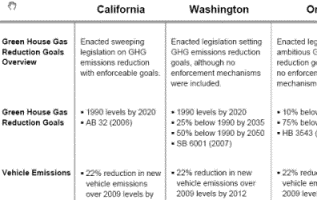Meet Justin our new research intern. He recently moved to Capitol Hill, in Seattle, from Corvallis, Oregon, where he got a Master’s Degree studying the effects of climate change on forest productivity, and where he tried to spend as much time outdoors as possible.
There has already been a mess of state climate legislation passed in Cascadia during 2007. But who has the time to make sense of all those targets, standards, and dates? (Who’s promising 10% below 1990 levels by 2020? How does Idaho compare to California? And wasn’t there some kind of renewable energy standard?) Well never fear, because I’ve sorted it all out in this nifty table. You can see how your state (or province) stacks up.
Full version here.
The upshot is that Cascadian lawmakers are trying to follow California’s lead on regulating greenhouse gas emissions. In the 2007 legislative session, both Oregon and Washington passed statewide goals for reducing GHGs. It was a good first step to establish a framework, and the goals themselves are ambitious. But ultimately, they’re only that: goals. Unfortunately, they don’t include binding enforcement mechanisms. Only California did that, with its AB 32 bill.
In addition to setting goals, many states enacted more concrete legislation to reduce future GHG emissions. (Again, check out this nifty table.) British Columbia, California, Montana, and Washington all recently banned the building of new coal power plants unless a significant portion of GHG emissions can be permanently sequestered. In California and Washington, the bans even extend to electricity purchased from out-of-state.
These same states also mandated that a large portion of their energy portfolio be generated by renewable sources in the coming years. And they took the lead on incorporating renewable fuels such as ethanol and biodiesel into gasoline. Both policies reduce GHG emissions, while creating jobs in the rapidly expanding renewable fuel and energy industries.
Especially intriguing are the incredibly ambitious goals laid out by BC Premier Gordon Campbell in his speech from the throne. In this speech Campbell laid out an exciting climate agenda, setting non-binding emissions reduction targets. BC recently joined with western states in establishing a regional carbon-trading scheme, and the provincial utility scrapped two coal-fired power plants in the works. Campbell picked up a lot of favorable press, but it remains to be seen if the Premiere will back up his boisterous talk with some actual legislation and legal mandates.
Some Cascadian governments are taking the lead nationally (and even internationally) to reduce GHG emissions. The next step may be getting Idaho, Alaska, and the federal governments of North America to start passing similarly aggressive laws.




Dan
Hi Justin. Good internship and I hope you go on to do good things.An interesting post topic might be to lay out the politics behind the release of the science that we already knew about postfire logging: what happened, what did the scientists think, how the message got railroaded, what happened to Dan Donato. Why? I think this is a good case study of both how politics hijacks the best of intentions, and how issues get framed. We already knew postfire logging was problematic, but how did this become controversial, and what does this mean to portraying and conveying a finding to the public?